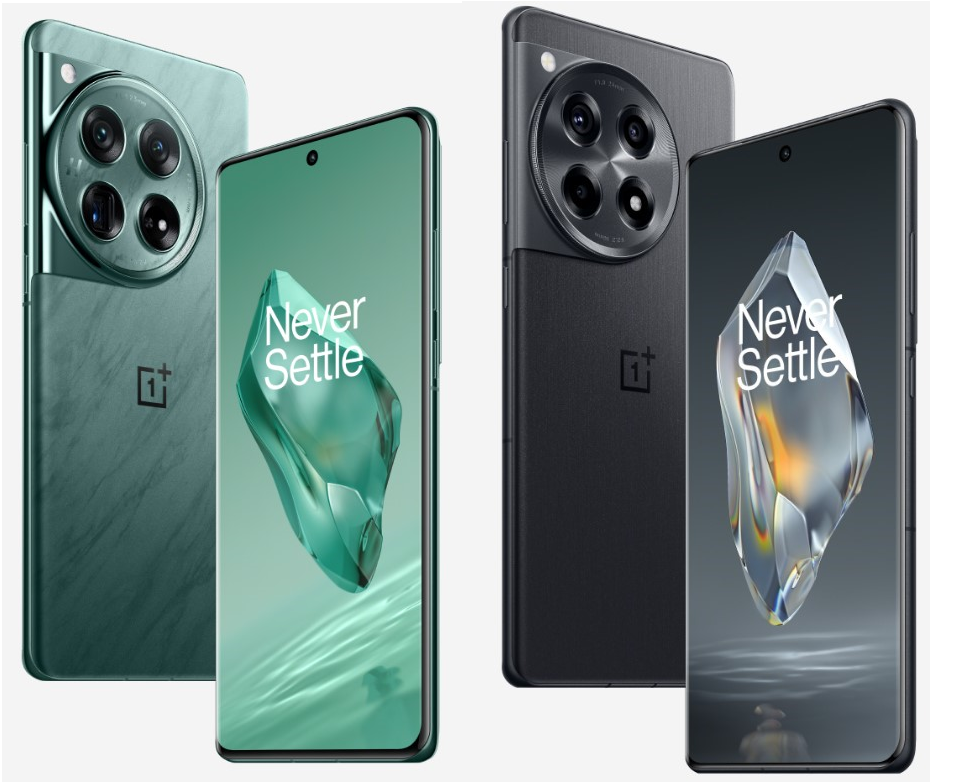OnePlus is probably not the best-known phone brand in Canada, since the major carriers haven’t picked it up, but it’s one that’s well worth a look. For the first time, its R series, previously only available in India and China, is available here and in the U.S.
OnePlus R Series devices, the company said, are “performance-focused flagships designed to give users the best mobile gaming experience possible. … Now, with more graphically intense mobile games launching worldwide, OnePlus has listened to the feedback of its users and will be bringing the OnePlus R Series to North America and Europe for the first time.”
Along with its higher-end sibling, the OnePlus 12, the OnePlus 12R was launched in January, and hit the stores last month. We had the opportunity to test both devices and here’s our take.
Although both phones are dubbed “flagship,” the 12’s specs top those of the 12R in a number of areas – including price. You’ll pay C$669.99 (list) for the base 12R (8 GB/128 GB), while the base model of the 12 (12 GB/256 GB) will set you back C$1069.99. Both are available from Amazon and Best Buy, or direct from OnePlus.
One area in which both phones shine, regardless of price, is in charging. If you set the included red cable next to a standard phone cable, you’ll see that it’s heftier, and the wired power supply is a proprietary rapid charger using OPPO’s SuperVOOC (Voltage Open Loop Multi-step Constant-Current Charging) technology. That means mind-bogglingly fast charging – about half an hour to get from zero to full charge.
The 12 also achieves results like that charging wirelessly, as long as you use the optional (C$69.99) OnePlus AIRVOOC wireless charger. The 12R, however, does not support wireless charging. But it does have a slightly bigger battery, and quite respectable battery life – a couple of days, at least, depending on usage. The 12 also sips power rather than slurping it, so you’ll get at least a couple of days of moderate use.
Another delightful feature for those of us who need respite from alerts is the slider on the left side of each device. It silences notifications so you’re not woken up at 3 a.m. by a partying pal, or disturbed during a meeting.
The phones themselves are, like most of today’s smartphones, smooth and sleek and a bit slippery. Investing in a case is a good idea. And, alas, they both lack headphone jacks, though OnePlus sells a C$12.99 adapter that plugs into the USB port.
The 12 is slightly heavier than the 12R (it’s bigger, so that makes sense). Yes, the specs suggest that the 12R is a slightly lesser phone, but you probably won’t notice much difference in performance from the older hardware components.
However, the biggest difference between the two devices is the camera. OnePlus partnered with high-end camera maker Hasselblad on the more advanced systems in the 12, while the 12R’s camera is more basic. It’s not terrible, just not as good as the 12’s. But they both pass the Black Cat Test, generating clear images of our long-suffering feline overlord. However, pointing both cameras at a full moon revealed, well, the 12R just sees a shiny disk and the 12 sees the moon, complete with its various craters and markings.
Admittedly, not many cameras are moon-friendly, and both devices handle more mundane things like flowers and icicles pretty well. You do get better zoom (3x optical) on the 12, and optical image stabilization on both telephoto and standard cameras, where the 12R only has OIS on its main camera. But I tried both in various lighting conditions and neither fell completely on its face.
That said, if the reason you’re switching phones is the camera, have a peek at these photos and see if the difference is worth the extra $300 or so for the 12. You may be surprised at which you prefer.
OnePlus’s take on Android, the Oxygen OS, has its quirks – for example, you check for system updates via the Security and Privacy menu in Settings, and the Close All button one would think would close all open apps closes all but one (and if there’s only one thing minimized, it just pulls it into focus – this is likely a bug) – so you may need to do some exploring to find things.
But it is running Android 14 under the covers, so is up-to-date (except for the AI features you’ll find in the Pixel 8 and Galaxy S24; they’re coming later). And OnePlus guarantees five years of security updates and four major Android updates for the 12, and four years of security updates and three major Android updates for the 12R. The hardware warranty is one year.
As you will see on the spec sheet below, both the OnePlus 12 and 12R are solid phones that offer good value – they’re well worth checking out.
OnePlus 12
OnePlus 12R
Processor
Qualcomm Snapdragon 8 Gen 3
Qualcomm Snapdragon 8 Gen 2
Display
6.82-inch ProXDR LTPO, 3168 × 1440 (510ppi), 120Hz adaptive refresh
6.78-inch ProXDR LTPO, 2780 × 1264 (450ppi), 120Hz adaptive refresh
RAM
12GB or 16GB LPDDR5X RAM
8GB or 16GB LPDDR5X
Storage
256GB or 512GB UFS 4.0
128GB or 256GB UFS 3.1
Battery
5,400mAh
5,500mAh
Ports
USB 3.2 Gen 1 (Type-C)
USB 2.0 (Type-C)
Front camera
32MP f/2.4 Sony IMX615
16MP
Rear camera
50MP f/1.6 Sony LYT-808 main w/OIS, 48MP f/2.2 Sony IMX581 ultrawide (114°), 64MP f/2.6 OmniVision OV64B 3x telephoto w/OIS
50MP f/1.8 Sony IMX890 main w/OIS, 8MP ultrawide Sony IMX355 (112°), 2MP macro
Connectivity
5G (no UWB), 4G, Wi-Fi 7, Bluetooth 5.4, NFC
5G (no UWB), 4G, Wi-Fi 7, Bluetooth 5.3, NFC
Dimensions
164.3 × 75.8 × 9.2mm
163.3 × 75.3 × 8.8mm
Weight
220g
207g
IP rating
IP65
IP64
Charging
80W wired SUPERVOOC, 50W wireless AIRVOOC
80W wired SUPERVOOC
Operating system
Android 14 (OxygenOS)
Android 14 (OxygenOS)



